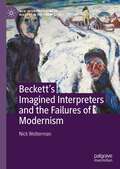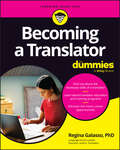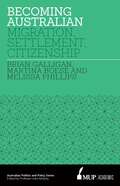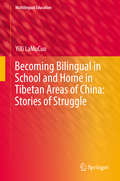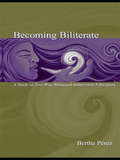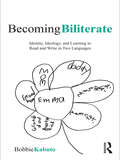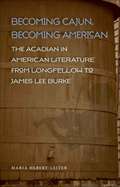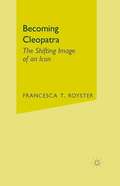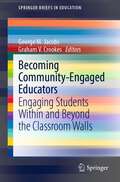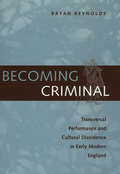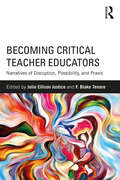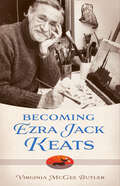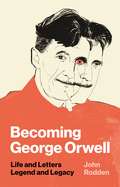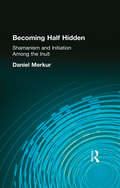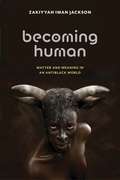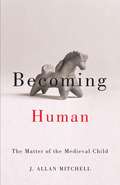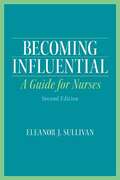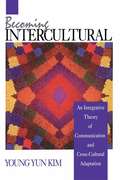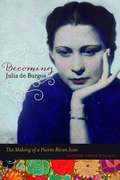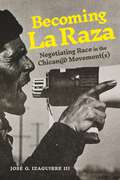- Table View
- List View
Beckett’s Imagined Interpreters and the Failures of Modernism (New Interpretations of Beckett in the Twenty-First Century)
by Nick WoltermanSamuel Beckett’s work is littered with ironic self-reflexive comments on presumed audience expectations that it should ultimately make explicable sense. An ample store of letters and anecdotes suggests Beckett’s own preoccupation with and resistance to similar interpretive mindsets. Yet until now such concerns have remained the stuff of scholarly footnotes and asides. Beckett’s Imagined Interpreters and the Failures of Modernism addresses these issues head-on and investigates how Beckett’s ideas about who he writes for affect what he writes. What it finds speaks to current understandings not only of Beckett’s techniques and ambitions, but also of modernism’s experiments as fundamentally compromised challenges to enshrined ways of understanding and organizing the social world. Beckett’s uniquely anxious audience-targeting brings out similarly self-doubting strategies in the work of other experimental twentieth-century writers and artists in whom he is interested: his corpus proves emblematic of a modernism that understands its inability to achieve transformative social effects all at once, but that nevertheless judiciously complicates too-neat distinctions drawn within ongoing culture wars. For its re-evaluations of four key points of orientation for understanding Beckett’s artistic ambitions—his arch critical pronouncements, his postwar conflations of value and valuelessness, his often-ambiguous self-commentary, and his sardonic metatheatrical play—as well as for its running dialogue with wider debates around modernism as a social phenomenon, this book is of interest to students and researchers interested in Beckett, modernism, and the relations between modern and contemporary artistic and social developments.
Becoming A Better Communicator: A Basic Course in Interpersonal and Public Communication
by Rhonda Gallagher Agena Farmer Susan Mcmurray Denise Miller Matthew OlsenBecoming a Better Communicator: A Basic Course in Interpersonal and Public Communication.
Becoming A Professional Reading Teacher
by R. Malatesha Joshi Diana QuatrocheAnswering the call for a comprehensive textbook on what reading teachers really need to know, this is the book that arms educators with not just the what and the how, but also the why that other texts don't cover. Two prominent literacy experts team with an elementary school specialist to give preservice teachers an easy-to-understand textbook that demystifies the research and incorporates everyday classroom experience. With its meticulous coverage of every aspect of effective reading instruction, this book ensures that general educators across grade levels learn the best techniques for teaching all key literacy skills get the clearest explanations available of the scientifically based research behind the strategies fully understand how and when literacy skills are acquired and what factors influence the process discover the best ways to teach students with learning disabilities, reading disabilities, and dyslexia get ready to conduct effective assessment of students' reading skills find out how to use the latest instructional technology to help advance students' literacy With its practical, research-based answers to the three most important questions literacy educators face—what to teach, how to teach, and why to teach the recommended way—this textbook will prepare future teachers to enter the classroom ready and motivated to implement best practices.
Becoming A Translator For Dummies
by Regina GalassoUnlock the intriguing world of translation and embark on a fulfilling career path Becoming A Translator For Dummies is your gateway to the exciting world of translation. This comprehensive guide will equip you with the tools and knowledge to succeed in this dynamic field, regardless of the specific field you choose to enter. Dr. Regina Galasso unveils the secrets of becoming a successful translator. You'll explore the different facets of translation, understand the nuances between translation and interpretation, and uncover the myriad exciting career opportunities available in this ever-expanding industry. Learn about the skills you’ll need to master to become a professional translator Explore freelance, part-time, and full-time job options, and market yourself effectively Discover specialized translation opportunities like legal, medical, technical, and literary translation Find top-notch translator programs and certificationsPrepare yourself for a career that knows no boundaries! Language enthusiasts, novice translators, and those already studying to become translation pros will love the valuable insights and practical advice in Becoming A Translator For Dummies.
Becoming Australian: Migration, Settlement and Citizenship
by Brian Galligan Martina Boese Melissa PhillipsThe year 2013 is the 40th anniversary of the end of the 'White Australia policy'. In these four decades Australia's immigration policy has shifted from a primary concern with cultural homogeneity or Britishness to a focus on demand-based skills through an increasingly fine-tuned system of points tests, occupation lists and employer-sponsored visas. Despite disproportionate politicisation of asylum seekers in recent public discourse, the intake of refugees and humanitarian entrants has remained relatively small. While Australia's contemporary migrant and refugee intake is truly multicultural, and governments continue to adhere to an official multicultural policy, integration into the Australian community and culture has been the dominant process, especially for second and third generation Australians. Australian identity and citizenship have changed in the last forty years, making Australia and its people more pluralistic and richly diverse. Becoming Australian focuses on the ways in which migrants and refugees meet the challenges of 'becoming Australian' and the transformative process for Australia and its people as they incorporate the continuing influx of multicultural peoples.
Becoming Bilingual in School and Home in Tibetan Areas of China: Stories of Struggle (Multilingual Education #34)
by YiXi LaMuCuoThis book contributes significantly to our understanding of bilingualism and bilingual education as a sociocultural and political process by offering analyses of the stories of five Tibetan individual journeys of becoming bilingual in the Tibetan areas of China at four different points in time from 1950 to the present.The data presented comprises the narrative of their bilingual encounters, including their experiences of using language in their families, in village, and in school. Opportunities to develop bilingualism were intimately linked with historical and political events in the wider layers of experiences, which reveal the complexity of bilingualism. Moreover, their experiences of developing bilingualism are the stories of struggle to become bilingual. They struggle because they want to keep two languages in their lives. It illustrates their relationship with society. They are Tibetans. L1 is not the official language of their country, but it is the tie with their ethnicity. It addresses bilingualism linked with the formation of identity.The unique feature of this book is that it offers a deep understanding of bilingualism and bilingual education by examining the stories of five individuals’ learning experiences over a period of almost 60 years.
Becoming Biliterate: A Study of Two-Way Bilingual Immersion Education
by Bertha PerezThis book describes the development process and dynamics of change in the course of implementing a two-way bilingual immersion education program in two school communities. The focus is on the language and literacy learning of elementary-school students and on how it is influenced by parents, teachers, and policymakers. Pérez provides rich, highly detailed descriptions, both quantitative and qualitative, of the change process at the two schools involved, including student language and achievement data for five years of program implementation that were used to test the basic two-way bilingual theory, the specific school interventions, and the particular classroom instructional practices. The contribution of Becoming Biliterate: A Study of Two-Way Bilingual Immersion Education is to provide a comprehensive description of contextual and instructional factors that might help or hinder the attainment of successful literacy and student outcomes in both languages. The study has broad theoretical, policy, and practical instructional relevance for the many other U.S. school districts with large student populations of non-native speakers of English. This volume is highly relevant for researchers, teacher educators, and graduate students in bilingual and ESL education, language policy, linguistics, and language education, and as a text for master's- and doctoral-level classes in these areas.
Becoming Biliterate: Identity, Ideology, and Learning to Read and Write in Two Languages
by Bobbie KabutoThrough the real-life context of one child learning to be bilingual and biliterate, this book raises questions and provides a context for pre-service and practicing teachers to understand and reflect on how children learn to read and write in multiple languages. Highlighting the social and cognitive advantages of biliteracy, its purpose is to help teachers better understand the complexity by which young children become biliterate as they actively construct meaning and work through tensions resulting from their everyday life circumstances. Perspectives regarding identity and language ideologies are presented to help teachers refine their own pedagogical approaches to teaching linguistically diverse children. Readers are engaged in understanding early biliteracy through a process of articulating and questioning their own assumptions and beliefs about learning in multiple languages and literacies.
Becoming Cajun, Becoming American: The Acadian in American Literature from Longfellow to James Lee Burke (Southern Literary Studies)
by Maria Hebert-LeiterFrom antebellum times, Louisiana's unique multipartite society included a legal and social space for intermediary racial groups such as Acadians, Creoles, and Creoles of Color. In Becoming Cajun, Becoming American, Maria Hebert-Leiter explores how American writers have portrayed Acadian culture over the past 150 years. Combining a study of Acadian literary history with an examination of Acadian ethnic history in light of recent social theories, she offers insight into the Americanization process experienced by Acadians -- who over time came to be known as Cajuns -- during the nineteenth and twentieth centuries.Hebert-Leiter examines the entire history of the Acadian, or Cajun, in American literature, beginning with Henry Wadsworth Longfellow's poem Evangeline and the writings of George Washington Cable, including his novel Bonaventure. The cultural complexity of Acadian and Creole identities led many writers to rely on stereotypes in Acadian characters, but as Hebert-Leiter shows, the ambiguity of Louisiana's class and racial divisions also allowed writers to address complex and controversial -- and sometimes taboo -- subjects. She emphasizes the fiction of Kate Chopin, whose short stories contain Acadian characters accepted as white Americans during the nineteenth and early twentieth centuries. Representations of the Acadian in literature reflect the Acadians' path towards assimilation, as they celebrated their differences while still adopting an all-American notion of self. In twentieth-century writing, Acadian figures came to be more often called Cajun, and increasingly outsiders perceived them not simply as exotic or mythic beings but as complex persons who fit into traditional American society while reflecting its cultural diversity. Hebert-Leiter explores this transition in Ernest Gaines's novel A Gathering of Old Men and James Lee Burke's detective novels featuring Dave Robicheaux. She also discusses the works of Ada Jack Carver, Elma Godchaux, Shirley Ann Grau, and other writers.From Longfellow through Tim Gautreaux, Acadian and Cajun literature captures the stages of this fascinating cultural dynamism, making it a pivotal part of any history of American ethnicity and of Cajun culture in particular. Concise and accessible, Becoming Cajun, Becoming American provides an excellent introduction to American Acadian and Cajun literature.
Becoming Centaur: Eighteenth-Century Masculinity and English Horsemanship (Animalibus)
by Monica MattfeldIn this study of the relationship between men and their horses in seventeenth- and eighteenth-century England, Monica Mattfeld explores the experience of horsemanship and how it defined one’s gendered and political positions within society.Men of the period used horses to transform themselves, via the image of the centaur, into something other—something powerful, awe-inspiring, and mythical. Focusing on the manuals, memoirs, satires, images, and ephemera produced by some of the period’s most influential equestrians, Mattfeld examines how the concepts and practices of horse husbandry evolved in relation to social, cultural, and political life. She looks closely at the role of horses in the world of Thomas Hobbes and William Cavendish; the changes in human social behavior and horse handling ushered in by elite riding houses such as Angelo’s Academy and Mr. Carter’s; and the public perception of equestrian endeavors, from performances at places such as Astley’s Amphitheatre to the satire of Henry William Bunbury. Throughout, Mattfeld shows how horses aided the performance of idealized masculinity among communities of riders, in turn influencing how men were perceived in regard to status, reputation, and gender.Drawing on human-animal studies, gender studies, and historical studies, Becoming Centaur offers a new account of masculinity that reaches beyond anthropocentrism to consider the role of animals in shaping man.
Becoming Centaur: Eighteenth-Century Masculinity and English Horsemanship (Animalibus: Of Animals and Cultures #9)
by Monica MattfeldIn this study of the relationship between men and their horses in seventeenth- and eighteenth-century England, Monica Mattfeld explores the experience of horsemanship and how it defined one’s gendered and political positions within society.Men of the period used horses to transform themselves, via the image of the centaur, into something other—something powerful, awe-inspiring, and mythical. Focusing on the manuals, memoirs, satires, images, and ephemera produced by some of the period’s most influential equestrians, Mattfeld examines how the concepts and practices of horse husbandry evolved in relation to social, cultural, and political life. She looks closely at the role of horses in the world of Thomas Hobbes and William Cavendish; the changes in human social behavior and horse handling ushered in by elite riding houses such as Angelo’s Academy and Mr. Carter’s; and the public perception of equestrian endeavors, from performances at places such as Astley’s Amphitheatre to the satire of Henry William Bunbury. Throughout, Mattfeld shows how horses aided the performance of idealized masculinity among communities of riders, in turn influencing how men were perceived in regard to status, reputation, and gender.Drawing on human-animal studies, gender studies, and historical studies, Becoming Centaur offers a new account of masculinity that reaches beyond anthropocentrism to consider the role of animals in shaping man.
Becoming Christian: Race, Reformation, and Early Modern English Romance
by Dennis Austin BrittonBecoming Christian argues that romance narratives of Jews and Muslims converting to Christianity register theological formations of race in post-Reformation England. The medieval motif of infidel conversion came under scrutiny as Protestant theology radically reconfigured how individuals acquire religious identities.Whereas Catholicism had asserted that Christian identity begins with baptism, numerous theologians in the Church of England denied the necessity of baptism and instead treated Christian identity as a racial characteristic passed from parents to their children. The church thereby developed a theology that both transformed a nation into a Christian race and created skepticism about the possibility of conversion. Race became a matter of salvation and damnation.Britton intervenes in critical debates about the intersections of race and religion, as well as in discussions of the social implications of romance. Examining English translations of Calvin, treatises on the sacraments, catechisms, and sermons alongside works by Edmund Spenser, John Harrington, William Shakespeare, John Fletcher, and Phillip Massinger, Becoming Christian demonstrates how a theology of race altered a nation’s imagination and literary landscape.
Becoming Cleopatra: The Shifting Image of an Icon
by Francesca T. RoysterCleopatra is one of our icons of “exotic” femininity. Sexy, political, and racially ambiguous--since the time of Shakespeare she has been a central character in popular culture. And, more often than not, Cleopatra has been imagined as the epitome of dangerous female sexuality. Moving fluidly from Shakespeare's England to contemporary Los Angeles, Francesca Royster looks at the performance of race and sexuality in a wide range of portrayals of Cleopatra. Royster begins with Shakespeare's original appropriation of Plutarch, and then moves on to analyze performances of the Cleopatra icon by Josephine Baker, and the on screen performances of Elizabeth Taylor, Tamara Dobson (Cleopatra Jones), and Queen Latifah (in Set It Off).
Becoming Community-Engaged Educators: Engaging Students Within and Beyond the Classroom Walls (SpringerBriefs in Education)
by Graham V. Crookes George M. JacobsThis book puts forth a call to engagement for educators at all levels of education and in all subject areas, with a focus on language education. Through using a grounded theory approach, it features semi-structured interviews, in a qualitative approach, with educators who embody community engaged education. Each chapter encompasses a case study that examines the interviewee's motivations, strategies, successes and failures. This book presents a local theory of community-engaged teachers and researchers to assist educators in developing as a community-engaged teacher or researcher. It asks and attempts to answer critical questions concerning the initial induction into community engagement, the maintenance of energy, commitment, and motivation, and the role of support networks. Through these, this book examines what is needed to sustain such an identity, and support campaigns of action or individual engagement over both the short and long term.
Becoming Criminal: Transversal Performance and Cultural Dissidence in Early Modern England
by Bryan ReynoldsIn this book Bryan Reynolds argues that early modern England experienced a sociocultural phenomenon, unprecedented in English history, which has been largely overlooked by historians and critics. Beginning in the 1520s, a distinct "criminal culture" of beggars, vagabonds, confidence tricksters, prostitutes, and gypsies emerged and flourished. This community defined itself through its criminal conduct and dissident thought and was, in turn,officially defined by and against the dominant conceptions of English cultural normality.Examining plays, popular pamphlets, laws, poems, and scholarly work from the period, Reynolds demonstrates that this criminal culture, though diverse, was united by its own ideology, language, and aesthetic. Using his transversal theory, he shows how the enduring presence of this criminal culture markedly influenced the mainstream culture's aesthetic sensibilities, socioeconomic organization, and systems of belief. He maps the effects of the public theater's transformative force of transversality, such as through the criminality represented by Shakespeare, Jonson, Middleton, and Dekker, on both Elizabethan and Jacobean society and the scholarship devoted to it.
Becoming Critical Teacher Educators: Narratives of Disruption, Possibility, and Praxis
by F. Blake Tenore Julie Ellison JusticeThe personal and professional are woven together in this collection of scholarly narratives by teacher educators who share their early critical experiences and model teaching practices to support continued resistance and possibilities in teacher education. Representing myriad contexts where teacher education takes place, the range of scholars included represent diverse racial, gendered, linguistic, economic, and ethnic intersectional perspectives. Each chapter suggests practical tools and encourages readers to reflect on their own journeys of becoming transformational teacher educators. This book adds an important dimension to the field with a new and generative approach to the introduction of critical literacies and pedagogies, and offers a potentially powerful way to explore theory, methodology, and social issues. Readers will enjoy the compelling storytelling of these powerful and vulnerable memoirs.
Becoming Ezra Jack Keats (Willie Morris Books in Memoir and Biography)
by Virginia McGee ButlerBecoming Ezra Jack Keats offers the first complete biography of acclaimed children’s author and illustrator Ezra Jack Keats (1916–1983) intended for adult readers. Drawing extensively from his unpublished autobiography and letters, Becoming Ezra Jack Keats covers the breadth of Keats’s life, taking readers through his early years as the child of immigrant parents, his introduction to illustration and writing, and the full arc of his remarkable career.Beyond a standard biography, this volume presents a time capsule of the political, social, and economic issues evolving during the span of Keats’s lifetime. It also addresses his trailblazing commitment to representation and diversity, most notably in his work The Snowy Day, which won the Caldecott Medal as the first full-color picture book to feature a Black child as the protagonist. Keats far surpassed his father’s prediction that he would be a starving artist. Instead, as shown in Becoming Ezra Jack Keats, he is now regarded as one of the most influential figures in children’s literature, having published twenty-two books translated into sixteen languages, all featuring the diversity he saw in the children outside the window of his Brooklyn studio.
Becoming George Orwell: Life and Letters, Legend and Legacy
by John RoddenThe remarkable transformation of Orwell from journeyman writer to towering iconIs George Orwell the most influential writer who ever lived? Yes, according to John Rodden’s provocative book about the transformation of a man into a myth. Rodden does not argue that Orwell was the most distinguished man of letters of the last century, nor even the leading novelist of his generation, let alone the greatest imaginative writer of English prose fiction. Yet his influence since his death at midcentury is incomparable. No other writer has aroused so much controversy or contributed so many incessantly quoted words and phrases to our cultural lexicon, from “Big Brother” and “doublethink” to “thoughtcrime” and “Newspeak.” Becoming George Orwell is a pathbreaking tour de force that charts the astonishing passage of a litterateur into a legend.Rodden presents the author of Animal Farm and Nineteen Eighty-Four in a new light, exploring how the man and writer Orwell, born Eric Arthur Blair, came to be overshadowed by the spectral figure associated with nightmare visions of our possible futures. Rodden opens with a discussion of the life and letters, chronicling Orwell’s eccentricities and emotional struggles, followed by an assessment of his chief literary achievements. The second half of the book examines the legend and legacy of Orwell, whom Rodden calls “England’s Prose Laureate,” looking at everything from cyberwarfare to “fake news.” The closing chapters address both Orwell’s enduring relevance to burning contemporary issues and the multiple ironies of his popular reputation, showing how he and his work have become confused with the very dreads and diseases that he fought against throughout his life.
Becoming Half Hidden: Shamanism and Initiation Among the Inuit
by Daniel MerkurFirst Published in 1993. Routledge is an imprint of Taylor & Francis, an informa company.
Becoming Human: Matter and Meaning in an Antiblack World (Sexual Cultures #53)
by Zakiyyah Iman JacksonWinner, 2021 Gloria E. Anzaldúa Book Prize, given by the National Women's Studies AssociationWinner, 2021 Harry Levin Prize, given by the American Comparative Literature AssociationWinner, 2021 Lambda Literary Award in LGBTQ StudiesArgues that Blackness disrupts our essential ideas of race, gender, and, ultimately, the humanRewriting the pernicious, enduring relationship between Blackness and animality in the history of Western science and philosophy, Becoming Human: Matter and Meaning in an Antiblack World breaks open the rancorous debate between Black critical theory and posthumanism. Through the cultural terrain of literature by Toni Morrison, Nalo Hopkinson, Audre Lorde, and Octavia Butler, the art of Wangechi Mutu and Ezrom Legae, and the oratory of Frederick Douglass, Zakiyyah Iman Jackson both critiques and displaces the racial logic that has dominated scientific thought since the Enlightenment. In so doing, Becoming Human demonstrates that the history of racialized gender and maternity, specifically anti-Blackness, is indispensable to future thought on matter, materiality, animality, and posthumanism. Jackson argues that African diasporic cultural production alters the meaning of being human and engages in imaginative practices of world-building against a history of the bestialization and thingification of Blackness—the process of imagining the Black person as an empty vessel, a non-being, an ontological zero—and the violent imposition of colonial myths of racial hierarchy. She creatively responds to the animalization of Blackness by generating alternative frameworks of thought and relationality that not only disrupt the racialization of the human/animal distinction found in Western science and philosophy but also challenge the epistemic and material terms under which the specter of animal life acquires its authority. What emerges is a radically unruly sense of a being, knowing, feeling existence: one that necessarily ruptures the foundations of "the human."
Becoming Human: The Matter of the Medieval Child
by J. Allan MitchellBecoming Human argues that human identity was articulated and extended across a wide range of textual, visual, and artifactual assemblages from the twelfth to the fifteenth centuries. J. Allan Mitchell shows how the formation of the child expresses a manifold and mutable style of being. To be human is to learn to dwell among a welter of things. A searching and provocative historical inquiry into human becoming, the book presents a set of idiosyncratic essays on embryology and infancy, play and games, and manners, meals, and other messes. While it makes significant contributions to medieval scholarship on the body, family, and material culture, Becoming Human theorizes anew what might be called a medieval ecological imaginary. Mitchell examines a broad array of phenomenal objects—including medical diagrams, toy knights, tableware, conduct texts, dream visions, and scientific instruments—and in the process reanimates distinctly medieval ontologies. In addressing the emergence of the human in the later Middle Ages, Mitchell identifies areas where humanity remains at risk. In illuminating the past, he shines fresh light on our present.
Becoming Influential: A Guide for Nurses
by Eleanor J. SullivanStill the only book of its kind, this intensely practical text helps nurses build the skills they need to gain and use influence throughout their entire careers. This second edition is updated throughout with new information on nursing, health care, and technology - including social media. Readable, timely, and upbeat, this book teaches through real-life examples, offering proven advice for using influence to solve many contemporary workplace problems. Self-assessments help readers evaluate their current organizational power, communication, goal-setting skills, negotiating and interviewing expertise, and even their abilities to manage confrontation. The book contains specific steps for career planning, resume building, career progress tracking, speech preparation, and more. Flexible learning activities include role plays, debates, observations, interviews, and networking assignments; up-to-date web and print resources support further exploration.
Becoming Intercultural: An Integrative Theory of Communication and Cross-Cultural Adaptation
by Young Yun KimThis book looks at the movements of immigrants and refugees and the challenges they face as they cross cultural boundaries and strive to build a new life in an unfamiliar place. It focuses on the psychological dynamic underpinning of their adaptation process, how their internal conditions change over time, the role of their ethnic and personal backgrounds, and of the conditions of the host environment affecting the process. Addressing these and related issues, the author presents a comprehensive theory, or a "big picture,"of the cross-cultural adaptation phenomenon.
Becoming Julia de Burgos: The Making of a Puerto Rican Icon
by Vanessa Perez RosarioWhile it is rare for a poet to become a cultural icon, Julia de Burgos has evoked feelings of bonding and identification in Puerto Ricans and Latinos in the United States for over half a century. In the first book-length study written in English, Vanessa Pérez-Rosario examines poet and political activist Julia de Burgos's development as a writer, her experience of migration, and her legacy in New York City, the poet's home after 1940. Pérez-Rosario situates Julia de Burgos as part of a transitional generation that helps to bridge the historical divide between Puerto Rican nationalist writers of the 1930s and the Nuyorican writers of the 1970s. Becoming Julia de Burgos departs from the prevailing emphasis on the poet and intellectual as a nationalist writer to focus on her contributions to New York Latino/a literary and visual culture. It moves beyond the standard tragedy-centered narratives of de Burgos's life to place her within a nuanced historical understanding of Puerto Rico's peoples and culture to consider more carefully the complex history of the island and the diaspora. Pérez-Rosario unravels the cultural and political dynamics at work when contemporary Latina/o writers and artists in New York revise, reinvent, and riff off of Julia de Burgos as they imagine new possibilities for themselves and their communities.
Becoming La Raza: Negotiating Race in the Chican@ Movement(s) (Rhetoric and Democratic Deliberation)
by José G. Izaguirre IIIIn 1965, striking farm workers in the San Joaquin Valley sparked the beginning of the Chican@ movement. As the movement quickly gained traction across the southwestern United States, public frictions emerged and splits among activists over strategic political decisions. José G. Izaguirre III explores how these disagreements often hinged on the establishment of a racial(ized) identity for Mexican Americans, leading to the formation of La Raza Unida, a political party dedicated to naming and defending Mexican Americans as a racialized community.Through close readings of figures, vocabularies, and visualizations of iconic texts of the Chican@ Movement—including El Plan de Delano, Rodolfo “Corky” Gonzales’s “I Am Joaquin,” and newspapers like El Grito del Norte and La Raza—Izaguirre demonstrates that la raza was never singular or unified. Instead, he reveals a racial identity that was (re)negotiated, (re)invented, and (re)circulated against a Cold War backdrop that heightened rhetorics of race across the globe and increasingly threatened Mexican American bodies in the Vietnam War. In lieu of a unified nationalist movement, Izaguirre argues that activists energized and empowered La Raza as a political community by making the Chican@ movement multivocal, global, and often aligned with whiteness.For scholars of political movements, US history, race, or rhetoric, Becoming La Raza will provide a valuable perspective on one of the most important civil rights movements of the twentieth century.
